Here’s a short video that perhaps captures the mystery of the world of Aia, which is the setting for the Bitterbynde Trilogy. It was originally made as a trailer for the audiobook of The Ill-Made Mute. I hope you enjoy it.
Category Archives: Fantasy
Inspirations for “The Churchyard Yarrow” & “Madigan’s Leap”
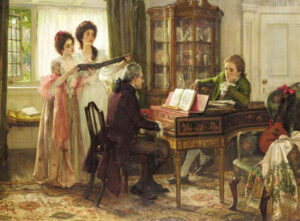
The inspiration for writing Madigan’s Leap in the first place was British and Irish folk music. I have always loved the lyrics and melodies of folk songs, and grew up listening to the music of, amongst others, Steeleye Span and Fairport Convention. The fascinating—and to me, unusual—lyrics of many of these songs taught me much about history.
In particular I found the horrific stories of press gangs in the 18th and early 19th century quite compelling. I felt driven to write a story about this onerous practice and the effect it must have had on young men, and indeed on entire families in that time and place.
Thus, thanks to music, I found myself writing about the last decade of the 19th century and the first few years of the 19th—in other words, the Regency era and the Napoleonic era.
Wikipedia says “The Regency era of British history is commonly applied to the years between c. 1795 and 1837, although the official regency for which it is named only spanned the years 1811 to 1820.”
“Madigan’s Leap” is set in an alternative version of Ireland during this era. It incorporates many aspects of the social, political and geographical elements of Ireland at that time, but I am a fantasy writer, after all, so this is a fantasy tale, and it bends many of the facts to suit the story.
I did my best, nonetheless, to clothe the characters in some of the (hopefully) historically accurate and exquisite costumes of that time. Most people agree, it was a time of exceptionally stylish attire for the military and for the wealthy. Isn’t that one of the many reasons we all love the novels of Jane Austen? 🙂 It is also said that “The uniforms of the Napoleonic Wars were some of the most elaborate and dashing in military history.”
The Churchyard Yarrow

Compliments of the Season!
As mentioned in my last post, Ford Street Publishing is producing a fantasy anthology in March 2024, and my story “The Churchyard Yarrow” is included. The book’s title is “Borderlands: Tales from the Edge — a new anthology.”
Let me tell you something about the background of my short story. It’s an excerpt from a work I’ve recently finished writing. The novel’s title is THE KING’S SHILLING, and it is Book #1 in a new trilogy called MADIGAN’S LEAP.
I began this work some while ago, and it was originally intended to be a short story.
I set it aside for what I thought was a year or two, but when I eventually looked at it again this year, my word processing software informed me that I had typed the first word in 2008. Even back then, the short story was taking on larger dimensions, because I had got as far as the middle of what is now Book #2 before setting it aside.
I recommenced the project, accepted the inevitable reality that it was expanding into three volumes, and completed the trilogy.
Yarrow

Achillea millefolium is commonly known as yarrow. Other common names include old man’s pepper, devil’s nettle, sanguinary, milfoil, soldier’s woundwort, and thousand seal.
You know that when a plant has many common names, it’s one that people find useful.
From Wikipedia: “In antiquity, the plant was known as herba militaris for its use in stanching the flow of blood from wounds. Other names implying its historical use in healing—particularly in the military—include bloodwort, knight’s milfoil, staunchweed, and, from its use in the United States Civil War, soldier’s woundwort.” [Wikipedia: Achillea millefolium]
It’s the “magical” uses of plants that also interests me. Historically, in Ireland, on May Day or the night before, women would place a stocking full of yarrow under their pillow before they went to sleep and recite:
Good morrow, good yarrow, good morrow to thee,
I hope by the yarrow my lover to see;
And that he may be married to me.
The colour of his hair and the clothes he does wear,
And if he be for me may his face be turned to me,
And if he be not, dark and surely may he be,
And his back be turned toward me.[Britten, James (1878). Folk-Lore Record. Vol. 1. Folklore Enterprises, Ltd., Taylor & Francis.]
Tanith Lee’s Nieces
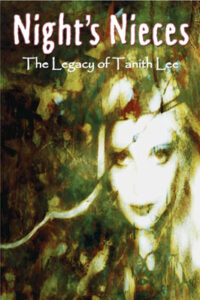
I have four works in this beautiful anthology, including poems and short stories. Here’s the blurb:
In the footsteps of the High Priestess of Fantasy… Tanith Lee – 1947-2015 – was a huge influence on fantasy literature, and a towering inspiration to a generation of writers, who were captivated by her iconic, poetic prose, her deft use of language, her surreal visions and her ground-breaking ideas.
Many successful authors claim that discovering the work of Tanith Lee encouraged them to write in the first place. In particular, she was instrumental in giving women writers the confidence to break the staid moulds of the genre – to be evocative, sensual and daring in their work, to smash boundaries.
Its title inspired by Tanith’s Flat Earth sequence of books, (in particular Night’s Master), Night’s Nieces is a collection of stories by female writers, who not only counted Tanith Lee as a close friend, but also as a mentor, a teacher and an inspiration. Tanith, having no children herself, considered these younger women to be her ‘nieces’ and offered her support to their writing. While the ‘nieces’ included in this book do not encompass all of Tanith’s close writer friends – for she had many – it amply provides a sample of her legacy.
Each ‘niece’ has written a short story inspired by Tanith’s work, as well as an accompanying article describing how Tanith influenced her career and sharing fond memories of her friendship. The book also includes previously unpublished photographs from Tanith’s life, as well as artwork by the authors.
Contributors include Storm Constantine, Cecilia Dart-Thornton, Vera Nazarian, Sarah Singleton, Kari Sperring, Sam Stone, Freda Warrington and Liz Williams. With an introduction by John Kaiine.
She: A book that influenced many authors.
SHE by H Rider Haggard (full title “She: A History of Adventure” “is one of the foundational works of fantasy literature, published around the time of The Princess and the Goblin (1858) by George MacDonald, William Morris’ The Wood Beyond the World and The Well at the World’s End, and the short stories of Lord Dunsany.”*
“Several authors, including JRR Tolkien, Rudyard Kipling, Henry Miller, Graham Greene and Margaret Atwood, have acknowledging its importance to their own and others’ writing. With more than 83 million copies sold, the novel is one of the best-selling fictional works of all time and has been translated into 44 languages.” [Wikipedia]
The Leaves of Gold Press edition of SHE includes an introduction written by me. It is also the first edition to contain illustrations from not one but four acclaimed artists who were contemporaries of JRR Tolkien, and whose works he admired:
- Maurice Greiffenhagen
- Charles H.M. Kerr
- E. K. Johnson, and
- G. C. Wilmshurst.
“She” was first published in book form in 1887. The story is an enduring classic, more than a century old. It’s a fantasy adventure packed with action, mystery, wonder, supernatural marvels and beauty, along with violence and darkness. While it bears some of the now-discredited hallmarks of the era in which it was written, it remains an enthralling page-turner. Critics consider it one of the most influential novels in modern literature.
Refreshingly, considering 19th century social attitudes, the story features a strong woman with a complex personality as the central character. Haggard’s representation of womanhood has received both praise and criticism.
SHE is one of those powerful stories whose popularity endures for centuries. The story has been made into movies and radio dramas.
Tolkien and SHE
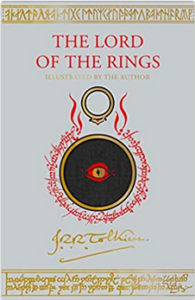
In common with every writer, Professor JRR Tolkien was influenced by many books. When he was growing up, he greatly enjoyed reading all the works of H. Rider Haggard. He stated in a 1966 interview, “I suppose as a boy SHE interested me as much as anything. . .”
Many interesting parallels can be drawn between “The Lord of the Rings” and SHE. Readers will find echoes of Galadriel and her mirror here, and arguably, even the literary progenitors of Frodo and The One Ring.
Tanith Lee and SHE

Tanith Lee’s superb science fantasy novel THE BIRTHGRAVE, first published in 1975, is also the first novel in The Birthgrave Trilogy. The story follows a nameless protagonist who awakens with amnesia. She travels across a fantastic, epic landscape on a quest to discover her past and her identity. The novel was nominated for the 1975 Nebula Award for best novel.
I was captivated by THE BIRTHGRAVE the moment I began to read it, and it remains one of the favourites on my bookshelves. On re-reading SHE, I began to see Haggard’s influence on Lee’s enchanting fantasy work. A volcano. An exotic, wild landscape. Ancient, ruined cities. Lost civilizations. A powerful, beautiful woman who is close to immortal. . .
Dart-Thornton and SHE

In turn, THE BIRTHGRAVE influenced my own writing. The beauty of Lee’s prose was a revelation to me, but more than that, I found the concept of someone who awakens with no memories, no past, no identity, deeply intriguing. That became the seed of THE BITTERBYNDE TRILOGY.
[Ref: Cornwell, Neil (1990). The Literary Fantastic: from Gothic to Postmodernism. New York: Harvester Wheatsheaf. ISBN 978-0-7450-0804-2. Also Clute, John (2002). Encyclopedia of Fantasy. New York: St Martin’s.]
Golden Hair

Photo by Gustavo Lacerda on Flickr angs school gustavo-lacerda-1
Available under Creative Commons Licence
“Katharine Briggs (8 November 1898 – 15 October 1980) was a British folklorist and writer, who wrote The Anatomy of Puck, the four-volume A Dictionary of British Folk-Tales in the English Language, and various other books on fairies and folklore. From 1969 to 1972, she was president of the Folklore Society, which established an award in her name to commemorate her life and work.” [Wikipedia]
Her book “A Dictionary of Fairies” has been a favourite of mine since childhood. I’ve read it again and again. I’ve loved it so much it started to fall apart and I had it re-bound. The book has since been published under the title, “An Encyclopedia of Fairies“.
Briggs was a passionate, accurate and thorough researcher. She had a PhD with a thesis on Folklore in seventeenth-century literature. She wrote many other books on fairies and folklore, as well as a number of children’s books. “A Dictionary of British Folk-Tales in the English Language: Part A: Folk Narratives (1970)” was re-published in three volumes in 2011 as Folk Tales of Britain, and is described by Philip Pullman in its introduction as the fullest and the most authoritative collection of British folktales that exists.
In 1969 Briggs was awarded the Doctorate in Literature, and made President of the Folklore Society, a post she held until 1972, and which named an award in her honour.
Briggs collected folk tales and fairy tales from people who had learned them, orally, from their forefathers. She found common threads, “types and motifs” within these tales, such as “Mortals as captives in Fairyland”, or “Tree spirits” or “Fairies steal”, or “Mortal not to thank fairy for gifts”. I use many of these motifs in my own work, which is inspired by British and Celtic folklore. One of them is “Golden hair”.
From Katharine Briggs’s “An Encyclopedia of Fairies”:
“GOLDEN HAIR. Some of the FAIRIES were golden-haired, as presumably were the TYLWYTH TEG, or Fair Family, many of the FAIRIES OF MEDIEVAL ROMANCES and the Irish fairies of the TIR NAN OG, but many of them were black-haired and brown-skinned.
“Fair or dark, however, they all set great store by golden hair in mortals. A golden-haired child was in far more danger of being stolen than a dark one. It was often a golden-haired girl who was allured away to be a FAIRY BRIDE, as EILIAN OF GARTH DORWEN was; sometimes, too, the fairies adopted girls of especial beauty, and above all golden-haired, as their special charges; and when they could not protect them they avenged their wrongs.
That said, there appear to be some disadvantages to having golden hair in the Real World!
“Blonde stereotypes are stereotypes of blonde-haired people. Sub-types of this stereotype include the “blonde bombshell” and the “dumb blonde”. Blondes are stereotyped as more desirable, but less intelligent than brunettes. There are many blonde jokes made on these premises. Although chiefly aimed at women, jokes of this style have also been aimed at similar stereotypes associated with men, such as the “dumb jock”, the “surfer dude” and “himbo”.
Wikipedia “Blonde stereotype”
Beautiful golden hair such as that which belongs to the young girl in Gustavo Lacerda’s photo may be the result of albinism, an inherited condition that leads to animals or people (of any race) having very light skin, hair, and eyes. People with albinism are often considered to have a unique beauty. Their hair may be white, auburn or golden.
WRITING TIP #5: The timing of inspiration
 Go With the Flow.
Go With the Flow.
I don’t know about other writers, but I find that inspiration can strike me at the most unexpected times.
These times are not entirely unpredictable – they’re usually periods when my mind is drifting; when I’m not thinking of anything in particular. That’s when inspiring, amazing, intriguing ideas will often bubble to the surface. If I sat down to “deliberately think”, this burst of creativity would probably not occur. It has to be spontaneous. And when inspiration hits, it feels like such a rush! And that is when, if at all possible, it’s best to put pen to paper.
When you do, pay no heed to spelling, grammar or punctuation – just write!
Walt Whitman, the great American poet, wrote:
The secret of it all is to write in the gush, the throb, the flood, of the moment—to put things down without deliberation—without worrying about their style—without waiting for a fit time or place. I always worked that way. I took the first scrap of paper, the first doorstep, the first desk, and wrote—wrote, wrote. … By writing at the instant the very heartbeat of life is caught.
Inspiration and Discipline
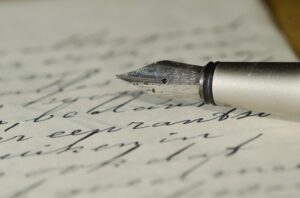
Write by hand
That said, it would be impossible (for me) to write a whole book if I only wrote when inspired. The inspired writing provides the basic “clay” from which the “sculpture” can be formed. It’s disciplined writing that finesses that basic clay. Disciplined writing takes place when that bright glow of inspiration has faded and you need to make sense of it all, insert “bridges” between scenes, get rid of any cliches that may have crept in, add some description, fix the spelling, grammar and punctuation, and so on.
There’s an interesting article that touches on this topic at The Write Practice, here. It’s called “Writing Inspiration: Do You Really Need It to Write?” by
The Asrai
The Asrai: Wights of the water.

Folklore
In English folklore the asrai are a species of aquatic faery that dwell in freshwater rivers and lakes. (Other aquatic fairies (or “wights”) include sea-dwelling mermaids and nixies, the human-like shapeshifting water spirits of Germanic folklore.)
The asrai are usually depicted as female. They tend to be timid and shy, and may be either quite small, 2–4 ft (0.61–1.22 m) tall, or tall and slender. Being faeries/spirits/wights, they are generally immortal, although they can perish if mistreated.
“Tales from Cheshire and Shropshire (UK) tell of a fisherman who captured an asrai and put it in his boat. It seemed to plead for its freedom in an unknown language, and when the fisherman bound it the touch of its cold wet hands burned his skin like fire, leaving a permanent mark. He covered the asrai with wet weeds, and it continued to protest, its voice getting fainter and fainter. By the time the fisherman reached the shore the asrai had melted away leaving nothing but a puddle of water in the boat, for it will perish if directly exposed too long to the sun. Their inability to survive daylight is similar to that of trolls from Scandinavian folklore.
“Other tales describe the asrai as having green hair and a fishtail instead of legs or may instead have webbed feet. They live for hundreds of years and will come up to the surface of the water once each century to bathe in the moonlight which they use to help them grow. If the asrai ( sees a man she will attempt to lure him with promises of gold and jewels into the deepest part of the lake to drown or simply to trick him. However, she cannot tolerate human coarseness and vulgarity, and this will be enough to frighten her away.”
[“Asrai” – Wikipedia]
Their oldest known appearance in print was the poem “The Asrai” by Robert Williams Buchanan, first published in April 1872, and followed by a sequel, “A Changeling: A Legend of the Moonlight.”
– – – – – – – – – – – – – – – – – – – – – – – – – – – – – – – – – – – – – – – – – –
“The Asrai” by Robert Williams Buchanan

“Before man grew of the four elements
The Asrai grew of three—fire, water, air—
Not earth,—they were not earthly. That was ere
The opening of the golden eye of day:
The world was silvern,—moonlight mystical
Flooded her silent continents and seas,—
And in green places the pale Asrai walked
To deep and melancholy melody,
Musing, and cast no shades.
“These could not die
As men die: Death came later; pale yet fair,
Pensive yet happy, in the lonely light
The Asrai wander’d, choosing for their homes
All gentle places—valleys mossy deep,
Star-haunted waters, yellow strips of sand
Kissing the sad edge of the shimmering sea,
And porphyry caverns in the gaunt hill-sides,
Frosted with gems and dripping diamond dews
In mossy basins where the water black
Bubbled with wondrous breath. The world was pale,
And these were things of pallor; flowers and scents,
All shining things, came later; later still,
Ambition, with thin hand upon his heart,
Crept out of night and hung the heights of heaven
With lights miraculous; later still, man dug
Out of the caves the thick and golden glue
That knits together the stone ribs of earth.
Nor flowers, nor scents, the pallid Asrai knew,
Nor burning aspiration heavenward,
Nor blind dejection downward under earth
After the things that glitter. Their desires
Shone stationary—gentle love they felt
For one another—in their sunless world
Silent they walked and mused, knowing no guile,
With lives that flow’d within as quietly
As rain-drops dripping with bright measured beat
From mossy cavern-eaves.”
WRITING TIP #4: Read only the best.
Read only the Best
 This, for me, is an essential writing tip!
This, for me, is an essential writing tip!
Zat Rana wrote, in an article for QUARTZ, published on 18 October, 2017:
QUALITY OVER QUANTITY: You “become” what you read.
“. . . I don’t think most of us internalize quite how much, and sometimes how subtly, what we read determines who we become.
“Input shapes your output.
“Language is our primary tool of communication. It’s how we build and organize our knowledge, and it’s what allows us to interact with each other.
“Outside of direct experience, it’s also largely how we create our perception of reality. The information your senses absorb through your surroundings combine to create linguistic (and subconscious) models in your mind about how the world works and the best way to interact with it.
“One part of this occurs through verbal conversation, or listening to something in general, but for most knowledge workers and for the average person in developed countries a larger part of it is directly a result of what we consume [via reading].
You are what you read. The information that you input into your mind informs your thinking patterns, and it influences your output in the form of the decisions you make, the work you produce, and the interactions you have.

“That’s a huge incentive to prioritize a block of time to think about what and how you consume [read], and whether or not you read adequately relative to the progress you want to make. It’s a reason to maybe pause and consider if you can do anything to purposefully shape the direction of your mind.
“Naturally, input doesn’t necessarily mean quantity. The correlation between how much you read or consume and what you can do or who you become begins to even off after a certain point, and more isn’t always better.
“This is entirely about what the quality of your predominant sources of input [books] are, and the importance of those can’t be overstated.”

Professor JRR Tolkien
Which authors have influenced my own writing over my lifetime?
Primarily, Professor JRR Tolkien and Tanith Lee, but also (in no particular order) –
Nicholas Stuart Gray, George MacDonald, John Keats,
William Shakespeare, Isaac Asimov, Eleanor Farjeon,
C.S. Lewis, Arthur C. Clarke, E. Nesbit,
Andre Norton, Ann McCaffrey, Charles Dickens,
George Eliot, Terry Pratchett, Jane Austen,
Ray Bradbury, Susannah Clark, Thomas Hardy,
Simon Winchester, Dianna Wynne-Jones, Douglas Adams,
Alan Garner, CS Lewis, Andrew Lang,
William Allingham, Hilda Lewis, Charles Kingsley,
Emily Brontë, Juliet Marillier, William Morris,
Ursula LeGuin, Jackie French, Walter de la Mare, and more.
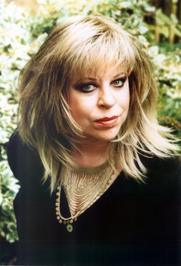
Tanith Lee
All these writers and poets have strongly influenced my inner worlds and contributed, in their own way. to the creation of the Bitterbynde Trilogy. In addition to giving me inspiration, they have also given me joy, peace, excitement, wonderment and delight. They have increased my vocabulary and helped me to look at the world in new ways.
Waterhorses
Waterhorses across the world

The Each Uisge. Image by Cecilia Dart-Thornton.
Certain folklore themes and motifs cover vast geographical areas. “Waterhorses” can be found in the folklore of England, Ireland, Scotland and Wales, as well as Scandinavian countries. Bodies of water such as lakes and rivers are so mysterious, elemental and often dangerous, it’s no wonder so many tales have evolved concerning creatures that might dwell beneath them.
Waterhorses can be benevolent, tricksy (practical jokers) or unseelie (malevolent). They may dwell in fresh water, such as mill ponds or wild forest pools, or in brackish inlets like sea lochs, in the ocean. Some of the waterhorse species are listed below.
Each-uisge
The each-uisge (Scottish Gaelic, literally “water horse”) is a water spirit in Scottish folklore, known as the each-uisce (anglicized as aughisky or ech-ushkya) in Ireland and cabyll-ushtey on the Isle of Man. It usually takes the form of a horse, and is similar to the kelpie but far more vicious.
The folklorist Katharine Briggs called the each-uisge “perhaps the fiercest and most dangerous of all the water-horses”.
Briggs says that the each-uisge is a shape-shifter, disguising itself as a fine horse, pony, a handsome man or an enormous bird. If, while in horse form, anyone mounts it, they are only safe as long as the each-uisge is ridden out of sight of water. However, the merest glimpse or smell of water means the beginning of the end for the rider, for the each-uisge’s skin becomes adhesive and the creature immediately plunges into the deepest part of the water with its victim. After the victim has drowned, the each-uisge tears him apart and devours the entire body except for the liver, which floats to the surface.
In its human form the each uisge is said to appear as a handsome man, who can only be recognised as a magical being by the long green ribbons of water weeds growing in its hair.
Nokken

Waterhorse by Brian Froud
The Norse Waterhorse, the Nokken, is a water demon that lives in rivers and lakes. He is able to transform himself into many shapes, and his purpose is to lure people to their doom.
A Nokken can change into:
-a grey/white horse, and if you ride this horse, you will ride to your death.
– a raft on the water. If you sit down on it, you will float away….to your death.
– a water lily. If you pick this flower, he will come up from the water and drag you down.
– a beautiful young man. If he seduces you, death will be your groom.
The Nokken is known by many other names, including the Nixie, Nixy, Nix, Näcken, Nicor, or Nok. (German: Nixe; Dutch: nikker, nekker; Danish: nøkke; Norwegian Bokmål: nøkk; Nynorsk: nykk; Swedish: näck; Faroese: nykur; Finnish: näkki; Icelandic: nykur; Estonian: näkk; Old English: nicor)
The southern Scandinavian version can transform himself into a horse-like kelpie, and is called a Bäckahästen (the “brook horse”).
Kelpie
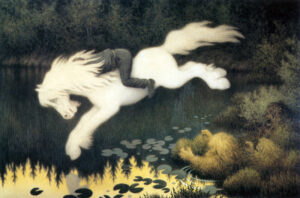
Boy on White Horse by Theodore Kittelsen
A kelpie, or water kelpie, is a shape-shifting spirit inhabiting lochs in Scottish folklore.
The kelpie is a powerful and beautiful black horse inhabiting the deep pools of rivers and streams of Scotland, preying on any humans it encounters. It is also able to shape-shift into human-like form.
In some cases, kelpies take their victims into the water, devour them, and throw the entrails to the water’s edge. In its equine form the kelpie is able to extend the length of its back to carry many riders together into the depths; a common theme in the tales is of several children clambering onto the creature’s back while one remains on the shore. Usually a little boy, he then pets the horse but his hand sticks to its neck. In some variations the lad cuts off his fingers or hand to free himself; he survives but the other children are carried off and drowned, with only some of their entrails being found later.
The origins of narratives about the creature are unclear but the practical purpose of keeping children away from dangerous stretches of water and warning young women to be wary of handsome strangers has been noted in secondary literature. [Wikipedia, “Kelpie”]
Ceffyl Dŵr
The Welsh version is called the Ceffyl Dŵr – literally “water horse”.
Nygel, Nigle, Nuggle, or Noggle
A relatively harmless, tricksy waterhorse of Orkney, who can spin his tail like a propeller. The tail is said to be “like the rim of an immense wheel turned up over his back.”
Nygels are supposed to appear near streams of running water, and particularly near water-mills, where, in the night, they might seized and hold fast the water-wheel with their
teeth, until people drove them away by throwing flaming brands at them.
Shoepultie or Shoopiltie ( Shetland Islands)
Shoopilties are as malevolent as kelpies.
– – – – – – – – – – – – – – – – – – – – – – – – – – – – – – – – – – – – – – – – – – – – – –
From THE ILL-MADE MUTE:

A white pearl shone like an eye in a hazy sky. The sun was past its zenith, sinking towards a wintry horizon. It cast a pale gleam over the waters of the lake. The entire surface was lightly striated with long ripples, shimmering in silken shades of grey. Through a frayed rent in the clouds, a crescent moon rode like a ghostly canoe, translucent. A flock of birds crossed the sky in a long, trailing V-formation. Their cries threaded down the wind – wild ducks returning home.
Dead trees reached their black and twisted limbs out of the waters, and near the shore, long water-grasses bowed before the breeze, their tips bending to touch their own trembling reflections. Tiny glitters winked in and out across the wavelets. The play of light and shadow masked the realm that lay beneath the lake. Nothing could be seen of the swaying weeds, the landscapes of sand and stone, the dark crevasses, any shapes that might, or might not, move deep under the water.
As the wild ducks passed into the distance, the tranquillity of the lake was interrupted. Faint and first, then louder, yells and laughter could be heard from the eastern shore. A band of Ertishmen was approaching.
Eight of them came striding along, and their long, tangled hair was as red as sunset. They were accompanied by dogs, retrievers wagging feathery tails. Baldrics were slung across the shoulders of the men, quivers were on their backs and longbows in their hands. At the belts of some swung a brace of fowl, tied by the feet. Already they had had a successful day’s hunting. Buoyed by success, their spirits were high. This last foray to the eastern shores of the lake was considered no more than a jaunt – they did not intend to hunt seriously, as was evidenced by the noise they were raising. They chaffed and bantered, teasing one another, sparring as they went along. All of them were young men, hale and strong – indeed, the youngest was only a boy.
“Sciobtha, Padraigh,” laughed the two eldest, slapping him on the back as he ran to keep up, “Ta ocras orm! Tu faighim moran bia!” The looks of the two Maghrain brothers were striking – tall, copper-haired twins in the leather kilts and heavy gold torcs of Finvarnan aristocracy. Their grins were wide and frequent, a flash of white across their brown faces.
“Amharcaim! Amharcaim!” shouted Padraigh suddenly, pointing to the black and leafless alders leaning at the lake’s edge. The men halted and turned their heads.
A shadow moved there. Or was it a shadow?
Gracefully, with arched neck, the stallion came walking out from among the trees. Clean were his lines, and well-moulded; long and lean his legs, finely tapered his frame. He had the build of a champion racehorse in its prime. His coat was sleek and glossy as the water of the lake. . .
– – – – – – – – – – – – – – – – – – – – – – – – – – – – – – – – – – – – – – – – – – – – – –
Further reading:
Briggs, Katharine (1976). An Encyclopedia of Fairies, Hobgoblins, Brownies, Boogies, and Other Supernatural Creatures. Harmondsworth, Middlesex: Penguin Books. pp. 115–16. ISBN 0-394-73467-X.



 Go With the Flow.
Go With the Flow. This, for me, is an essential writing tip!
This, for me, is an essential writing tip!